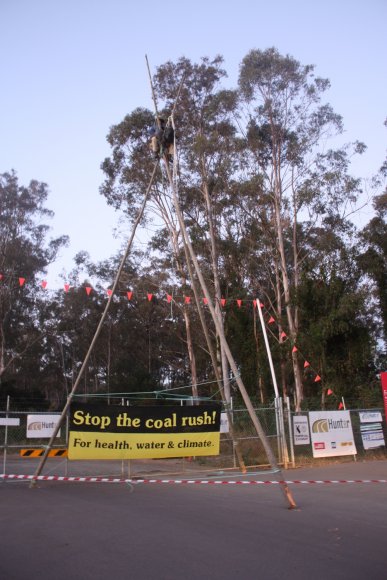
by Deep Green Resistance News Service | Jun 5, 2013 | ANALYSIS, Strategy & Analysis
Industrial civilization is killing the planet. It is, by its very nature, entirely dependent upon tearing & rending apart the fabric of the living world for the raw materials which sustain industrial society. As civilization fells ever more forests, blows apart ever more mountains, dams ever more rivers, vacuums ever more fisheries, drains ever more wetlands, plows ever more prairies, and replaces ever more of the natural world with concrete and fields growing food for solely human use, the bloody hands of empire must reach ever further afield to grasp for new pockets of wilderness to seize.
As industrial society becomes more and more globalized, so too does industrial destruction. Wild places that may once have been too remote to access find the crushing weight of civilization brought to bear upon them.
While the reach and presence of this way of life accelerate around the planet, the privileges and material prosperities afforded by its war against life remain the property of a small minority at the center of empire. It is to this center that the overwhelming portions of planetary plunder flow. It’s coded into the way empires—and civilizations—operate. The center of power conquers outlying lands, colonizing them and forcefully extracting resources, which flow back to feed the bloated power base.
The pattern is the same, whether we’re talking about cities extracting food via agriculture from the surrounding lands or the global economy extracting oil, steel, wood, etc. from the Global South. It is the same dynamic of empire—of colonies and conquerors. We may rationalize the pattern through complex social and economic theory, but it doesn’t change the underlying relationship of exploiter and exploited.
Central to the smooth function of this way of life are the logistics and transportation necessary to physically transport those materials from the site of extraction to the center of empire. The global economy is incredibly complex, so much so that how exactly it operates in the physical world may seem inexplicable, and only comprehensible in the abstract. But despite this, there are very specific infrastructures—foundations of support—that are fundamental to its function. The infrastructure of globalized transportation and logistics is among these; without them, the precarious balance of industrial society would collapse.
In the incessant drive towards ever-greater efficiency—the drive to expand “economic production” (read the conversion of living landbases into private wealth) beyond any limitations—the industrial economy is becoming ever more dependent upon fast-paced transportation and logistics. It’s why most grocery stores only have a 72 hour supply of food in-store. By reducing inventory capacity and relying upon “Just-in-Time” transportation systems, industrialism has accelerated its pace, but at the expense of its stability.
For those who understand the destruction and horror that is this way of life—those who understand that it must be stopped and dismantled at any cost—the centrality and fragility of the systems responsible for the transportation of resources & goods presents a strategic target for disruption and sabotage.
Fortunately, these transportation networks are large and poorly defended. A paper recently released by the Macdonald-Laurier Institute, written by Douglas Bland, cited the criticality and vulnerability of Canada’s rail transport infrastructure as weaknesses which could be exploited to cripple the entire Canadian economy. The report talks specifically about the potential of an “aboriginal uprising” in Canada and how such a mobilization could impact the industrial economy of the nation:
In the event of an insurgency, the Canadian economy could be shut down in weeks. The 2012 CP Rail strike cost an estimated $540-million a week, as it hit industries including coal, grain, potash, nickel, lumber and autos. Some First Nations leaders like Terry Nelson in Manitoba have already concluded that a covert operation involving burning cars on every railway line would be impossible to stop.
This vulnerability in the structure of modern civilization is present outside of Canada; indeed, it is characteristic of the global economy. These transportation and logistical networks—those that connect and maintain the flow between the different nodes of industrial production—are fragile, sprawling, and poorly guarded. And they’re very vulnerable to sabotage.
As just one recent example, some anonymous folks sabotaged rail lines in Central Oregon in celebration of May Day a month ago. In their own words,
Late at night on May Day we sabotaged a rail line in Central Oregon to interrupt the flow of commodities. Capital depends more than ever on the metropolis, the constant flow of commodities, services, capital, information, and any interruption of that flow is a small victory… This action was quick and easy. Using copper wire with the ends stripped, we wrapped both ends of wire around the rail and buried the middle section. This sends a false signal that there is a train on the tracks, delaying any other movement until the blockage is cleared.
Like many forms of sabotage, it doesn’t take much, as the communique issued by those behind this particular action so kindly describes.
Of course, while we understand that disrupting a single rail line on a single night will have little to no measurable impact on the masticating gears of industrialism, such sustained actions—as described by Bland’s paper—could translate into effective systems disruption. With the whole of the globalized economy so dependent upon such a precarious & precisely balanced transportation infrastructure, the impacts of such a campaign of sabotage could have massive and far reaching effects.
This way of life cannot last. It remains steady and standing only through actively destroying and consuming the fabric of the living world. The movement of materials—the blood soaked corpses of its victims—through the industrial system is central to this. To stop that movement is to stop the machine. While it may not be the first course of action many would turn to, and while it may make some uncomfortable, sustained and coordinated sabotage against the industrial transport infrastructure presents a strategic way to disrupt and halt the monstrous activity of industrial civilization.
Civilization is not static; it is a holocaust in motion. As we all know, an object in motion stays in motion, unless acted upon by an outside force. It’s long past time to apply that force.
Time is Short: Reports, Reflections & Analysis on Underground Resistance is a biweekly bulletin dedicated to promoting and normalizing underground resistance, as well as dissecting and studying its forms and implementation, including essays and articles about underground resistance, surveys of current and historical resistance movements, militant theory and praxis, strategic analysis, and more. We welcome you to contact us with comments, questions, or other ideas at undergroundpromotion@deepgreenresistance.org
Photo by American Public Power Association on Unsplash
by Deep Green Resistance News Service | Jan 2, 2013 | Indigenous Autonomy, Obstruction & Occupation
By Jorge Barrera / APTN
First Nations leaders have discussed plans to launch country-wide economic disruptions by the middle of January if Prime Minister Stephen Harper doesn’t agree to hunger-striking Attawapiskat Chief Theresa Spence’s demand for a treaty meeting, APTN National News has learned.
During three days of meetings and teleconferences, chiefs from across the country discussed a plan setting Jan. 16 as the day to launch a campaign of indefinite economic disruptions, including railway and highway blockades, according to two chiefs who were involved in the talks who requested anonymity.
“The people are restless, they are saying enough is enough,” said one chief, who was involved in the discussions. “Economic impacts are imminent if there is no response.”
Chiefs were still finalizing details of their plans Monday evening and it remained unclear to what extent their discussed options would translate into the official position.
Assembly of First Nations National Chief Shawn Atleo is expected to write Harper a letter outlining the chiefs’ position.
Spence launched her hunger strike on Dec. 11 to force a meeting between Prime Minister Stephen Harper, Governor General David Johnston and First Nations leaders to discuss the state of the treaties. Spence said in a statement issued Monday that the aim of the meeting was to “re-establish” the treaty relationship and finally put First Nations people in their “rightful place back here in our homelands that we all call Canada.”
The plan of action comes as the Idle No More movement continues to sweep across the country through round dances, rallies along with highway and rail blockades.
The Tyendinaga Mohawks briefly blockaded a main CN rail line between Toronto and Montreal Sunday, stranding about 2,000 Via Rail passengers. The Mi’kmaq from the Listuguj First Nation, Que., continue to hold a rail blockade on a CN line along with members of the Aamjiwnaang First Nation who have shut a CN line in Sarnia, Ont. In British Columbia, the Seton Lake Indian Band ended a rail blockade on Sunday.
How the chiefs’ action plan will mesh with the Idle No More movement remains to be seen. Idle No More organizers issued a statement Monday that distanced the movement from the chiefs.
“The chiefs have called for action and anyone who chooses can join with them, however, this is not part of the Idle No More movement as the vision of this grassroots movement does not coincide with the visions of the leadership,” said the statement, posted on the Idle No More Facebook page. “While we appreciate the individual support we have received from chiefs and councillors, we have been given a clear mandate by the grassroots to work outside the systems of government and that is what we will continue to do.”
One of the chiefs involved in action plan discussion said the leadership wanted to be sensitive to the grassroots-driven movement and make clear that their plans are being developed in support and as a response to Idle No More.
“Chiefs are standing firm in support of Idle No More and grassroots citizens,” said the chief. “We now need to unify.”
Read more from APTN

by Deep Green Resistance News Service | Oct 6, 2012 | Colonialism & Conquest, Indigenous Autonomy, Mining & Drilling, Obstruction & Occupation
By Survival International
A protest involving Earth’s most threatened tribe, the Awá, has forced the world’s largest iron ore mine to suspend operations along its main railway line.
On Tuesday, hundreds of Indians including the Awá, took to the tracks of Vale’s Carajás railway to voice their opposition to Brazilian government plans that could weaken their land rights, if legalized.
The demonstration follows months of anger surrounding a draft text called Directive 303, which prohibits the expansion of indigenous territories.
The government has refused to scrap the proposed directive, despite it violating national and international laws by suggesting certain projects can be carried out on Indian land without proper consultation.
Frustrations spilled over on Tuesday, with several different tribes uniting to demand that their land rights are respected.
The blockade is the latest in a string of controversies to involve mining giant Vale, whose railway borders the territory of the Awá.
Last month, a judge reversed a ruling that had stopped the company from doubling its railway line to increase production.
The decision was a blow for the Awá, who blame the railway for bringing thousands of invaders into their lands and scaring off the animals they hunt.
Survival’s Director Stephen Corry said today, ‘If Brazil wants to lead the way and show the world that it respects its indigenous peoples, it should not be entertaining the harmful propositions of a handful of rural lobbyists. This protest shows that for tribes like the Awá, land rights are make or break.’
From Survival International: http://www.survivalinternational.org/news/8722

by Deep Green Resistance News Service | Sep 5, 2012 | Mining & Drilling, Obstruction & Occupation
By Rising Tide Australia
Activists entered the Hunter 8 Alliance compound at Rutherford before dawn today, erecting a wooden tripod to block access to the site, which is part of a Federally funded project to increase coal haulage capacity in the Hunter Valley. Activist Ned Haughton scaled the 10 metre high structure, where he remained for the next five and a half hours. Haughton has now been arrested, and will be charged with obstruction.
Steve Phillips, spokesperson for protest organisers Rising Tide, said: “This railway construction project is designed purely for the benefit of coal corporations, yet it is being paid for with taxpayers money.”
“Why are taxpayers dollars being handed over to rich mining corporations, in order to prop up a polluting industry that is destroying human health and the environment?”
“There is a coal rush under way in NSW, and public health, waterways, ecosystems, and the global climate are under assault. Massive coal mine projects, coal haulage projects, and coal port projects are in the pipeline. If all these projects go ahead, the consequences will be devastating.”
Today’s protest follows two consecutive days of community direct action against the Boggabri mine in the Gunnedah Basin – the coal industry’s “new frontier”. A major expansion of the Boggabri coal mine was approved by the NSW Government in July despite huge ecological impacts and overwhelming community opposition.
“We call on State and Federal Governments to abandon their infatuation with mining companies, and their addiction to fossil fuels. It’s time to take a stand and stop this coal rush before it’s too late.”
Key facts.
- The Maitland to Minimbah Third Track project is being constructed by Hunter 8 Alliance, which is a consortium of engineering company GHD, construction company John Holland, and the Federally owned Australian Rail Track Corporation.
- The objective of the project is to lift coal haulage capacity on the Hunter rail corridor to 200 million tonnes per annum. It includes construction of 23km of new rail track, and reconditioning of 9km of existing track.
- The Federal Government granted $114 million, through the ARTC, to the project.
From Rising Tide Australia

by Deep Green Resistance News Service | May 3, 2012 | Obstruction & Occupation
By Steve Lyttle / Charlotte Observer
Six people were arrested Thursday morning in Catawba County after a group of protesters from Greenpeace and three other organizations blocked a train from entering Duke Energy’s steam-powered plant in Catawba County by chaining themselves to the tracks.
The group aimed the protest at Duke Energy, for its use of coal-powered plants, and at technology giant Apple. Leaders of the action said they are protesting Apple because it is using Duke Energy power for the expansion of its data center at Maiden in Catawba County.
“The group was able to stop the train from passing by,” said Molly Dorozenski, a Greenpeace spokesperson.
The Catawba County Sheriff’s Office confirmed that arrests were made. According to reports from the scene, four people who had chained themselves to the tracks were taken into custody, along with two others at the scene.
The action came at the same time as Greenpeace demonstrators were outside Duke Energy’s corporate headquarters in Charlotte’s uptown, protesting during the company’s shareholders meeting.
Dorozenski said the incident began Thursday morning when a train carrying coal arrived at the Marshall Steam Station. She said four activists chained themselves to the tracks, to prevent the train from delivering coal. She said other protesters put the Apple logo on train cars, to show the group’s belief that Apple is profiting by Duke Energy’s use of coal.
Greenpeace contends the use of coal is creating an environmental hazard, and that coal mining is damaging to the ecology of the Appalachia region.
Joining Greenpeace in blocking the train were members of Radical Action for Mountain People’s Survival (RAMPS), Katuah Earth First! and Keepers of the Mountains Foundation, according to Greenpeace.
“Duke is using data center expansion in North Carolina, like Apple’s, to justify reinvesting in old coal-fired power plants and even worse — as an excuse to build new coal and nuclear plants,” said Gabe Wisnieweski, Greenpeace’s USA Coal Campaign director.
“The climate and communities throughout Appalachia and North Carolina are paying the price for Apple and Duke’s short-sighted decisions,” he added.
Read more from The Charlotte Observer:




